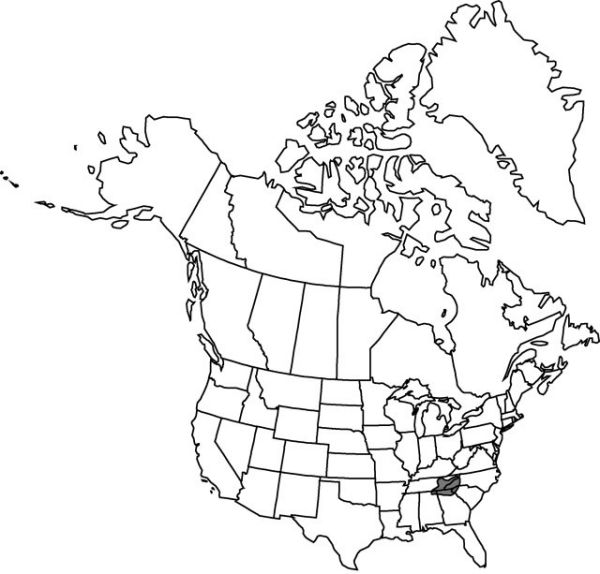Difference between revisions of "Trillium vaseyi"
Biltmore Bot. Stud. 1: 24. 1901.
FNA>Volume Importer |
imported>Volume Importer |
||
| (6 intermediate revisions by 2 users not shown) | |||
| Line 8: | Line 8: | ||
}} | }} | ||
|common_names=Sweet beth;sweet trillium;Vasey’s trillium | |common_names=Sweet beth;sweet trillium;Vasey’s trillium | ||
| + | |special_status={{Treatment/ID/Special_status | ||
| + | |code=E | ||
| + | |label=Endemic | ||
| + | }} | ||
|basionyms= | |basionyms= | ||
|synonyms={{Treatment/ID/Synonym | |synonyms={{Treatment/ID/Synonym | ||
|name=Trillium erectum var. vaseyi | |name=Trillium erectum var. vaseyi | ||
|authority=(Harbison) H. E. Ahles | |authority=(Harbison) H. E. Ahles | ||
| + | |rank=variety | ||
}} | }} | ||
|hierarchy=Liliaceae;Trillium;Trillium subg. Trillium;Trillium vaseyi | |hierarchy=Liliaceae;Trillium;Trillium subg. Trillium;Trillium vaseyi | ||
| Line 27: | Line 32: | ||
|elevation=300–700 m | |elevation=300–700 m | ||
|distribution=Ala.;Ga.;N.C.;S.C.;Tenn. | |distribution=Ala.;Ga.;N.C.;S.C.;Tenn. | ||
| − | |discussion=<p>Although sometimes submerged within Trillium erectum, T. vaseyi has a later blooming season, a nodding flower of much larger size, a sweet fragrance, and cove habitat unlike that of T. erectum. In my garden hybridization experiments, T. vaseyi hybrids have different color patterns than T. erectum hybrids. Trillium vaseyi is clearly a distinct species. It frequently hybridizes with T. rugelii.</p> | + | |discussion=<p>Although sometimes submerged within <i>Trillium erectum</i>, <i>T. vaseyi</i> has a later blooming season, a nodding flower of much larger size, a sweet fragrance, and cove habitat unlike that of <i>T. erectum</i>. In my garden hybridization experiments, <i>T. vaseyi</i> hybrids have different color patterns than <i>T. erectum</i> hybrids. <i>Trillium vaseyi</i> is clearly a distinct species. It frequently hybridizes with <i>T. rugelii</i>.</p> |
|tables= | |tables= | ||
|references= | |references= | ||
| Line 36: | Line 41: | ||
-->{{#Taxon: | -->{{#Taxon: | ||
name=Trillium vaseyi | name=Trillium vaseyi | ||
| − | |||
|authority=Harbison | |authority=Harbison | ||
|rank=species | |rank=species | ||
| Line 50: | Line 54: | ||
|publication title=Biltmore Bot. Stud. | |publication title=Biltmore Bot. Stud. | ||
|publication year=1901 | |publication year=1901 | ||
| − | |special status= | + | |special status=Endemic |
| − | |source xml=https:// | + | |source xml=https://bitbucket.org/aafc-mbb/fna-data-curation/src/2e0870ddd59836b60bcf96646a41e87ea5a5943a/coarse_grained_fna_xml/V26/V26_117.xml |
|genus=Trillium | |genus=Trillium | ||
|subgenus=Trillium subg. Trillium | |subgenus=Trillium subg. Trillium | ||
Latest revision as of 21:12, 5 November 2020
Rhizomes short, stout, praemorse. Scapes 1–2 per rhizome terminus, round in cross section, 3–6.5 dm, ± slender to stout, glabrous. Bracts sessile to subsessile; blade rhombic, 10–20 × 6–20 cm, often wider than long, not glossy, base attenuate, apex acuminate. Flower carried beneath bracts, odor faintly sweet; sepals spreading, pale green, lanceolate-acuminate, 25–50 × 6–18 mm, margins involute, apex acuminate; petals spreading to recurved distally, adaxially crimson, maroon-red, or brownish red, abaxially paler, grayish pink or rose, veins engraved, ovate-suborbicular, 3–6.5 × 4–6 cm, somewhat fleshy, base rounded and overlapping, margins entire, apex acute; stamens conspicuous, ± erect to weakly recurved, 15–25 mm, longer than pistil at anthesis; filaments grayish purple to blackish purple, longer than anthers, 5–12 mm, slender; anthers weakly recurving, grayish purple to maroon, slender, dehiscence introrse; connectives purple, barely equaling anther sacs; ovary small, maroon or dark reddish purple, ± globose to conical-pyramidal, 6-ridged, 3–12 mm, basal attachment less than ovary width; stigmas erect, recurved, distinct, gray-purple, not lobed adaxially, basally widened, ± linear distally, 2.5–6.5 mm, fleshy; pedicel horizontal to declined-drooping, ± straight, 2–13 cm. Fruits dark reddish maroon, ovoid, obtusely angled, relatively small, 1–1.4 × 1–2 cm, pulpy. 2n = 10.
Phenology: Flowering mid–late spring (late Apr–early Jun).
Habitat: Rich woods, often on steep slopes, ravines, stream banks, and deep, wind-sheltered, moist coves
Elevation: 300–700 m
Distribution

Ala., Ga., N.C., S.C., Tenn.
Discussion
Although sometimes submerged within Trillium erectum, T. vaseyi has a later blooming season, a nodding flower of much larger size, a sweet fragrance, and cove habitat unlike that of T. erectum. In my garden hybridization experiments, T. vaseyi hybrids have different color patterns than T. erectum hybrids. Trillium vaseyi is clearly a distinct species. It frequently hybridizes with T. rugelii.
Selected References
None.